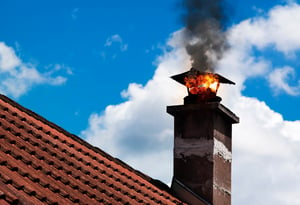 As the days get shorter, and the leaves start changing, you may be tempted to light a fire in your wood burning fireplace. While it’s enjoyable to sit and relax by a nice, warm fire, if you haven’t had your chimney inspected or cleaned this year, I would recommend holding off.
As the days get shorter, and the leaves start changing, you may be tempted to light a fire in your wood burning fireplace. While it’s enjoyable to sit and relax by a nice, warm fire, if you haven’t had your chimney inspected or cleaned this year, I would recommend holding off.
September 30 – October 6 is National Chimney Safety Week. On average, 22,200 chimney fires occur in the U.S. each year. With proper inspections and cleaning, these fires can be prevented.
Neglected chimneys can destroy your home or injure your family. While some chimney fires burn wildly out of control, others can burn discretely without you ever knowing.
Here are some signs of a chimney fire:
- Loud crackling and popping noise;
- Dense smoke;
- A strong hot smell; and
- Loud rumbling sound.
Slow burning chimney fires may not be visible, but still can cause damage to your chimney or home.
Here are visible defects indicating you’ve had a small chimney fire:
- Warped metal;
- Cracked or collapsed flue tiles;
- Damaged roofing material;
- Cracks in exterior masonry;
- Pieces of creosote on your roof; and
- Smoke seeping through mortar joints.
An inspection by a certified and reputable company will be able to explain what’s going on with your chimney.
Understanding what causes chimney fires is the best medicine for keeping your family safe:
1. Creosote buildup. Creosote is a residue that travels up your chimney and builds up on your flue over time. In fact, some creosote builds up every time a wood burning fireplace is lit. If that residue isn’t properly cleaned out, the chance of a fire igniting in your chimney increases.
2. Clay flue liner defects. Over time, liners can crack allowing hot gases to escape. If the hot gases enter into the home, they can cause nearby framing to ignite.
3. Improper maintenance. Cracked cement in and around the fireplace can cause hot gases to escape as well.
4. Improper installation. Proper installation is critical to keeping your family safe. The National Fire Protection Association, fireplace manufacturers, and venting manufacturers have recommended guidelines for safe and proper installation.
5. Other causes. Fires can start for a number of additional reasons such as:
- Too much wood in the fireplace;
- Faulty igniter or connections;
- No grate;
- Damaged damper;
- Bird nest or debris buildup; and
- Low hanging tree branches.
If you enjoy a gas fireplace, here are a few things to check annually:
- Inspect the glass for cracks;
- Inspect the latches to make sure they still securely hold the glass;
- Make sure the logs haven’t shifted;
- Make sure the gas shut-off valve stops the flow of gas and test the igniter; and
- Inspect the burner for clogged holes. If a burner hole is clogged, turn off the gas and clear the obstruction(s) with a pin or small needle.
To learn more, download our free eBook, Chimney and Fireplace Safety Guide.
If you think your chimney is on fire, get out of your home immediately and call 911. Depending on the type of fire, it could spread through your home quickly.
Do you have any tips or information you’d like to share? I’d love to hear them; please share them in the box below.
Source:
http://www.csia.org/





